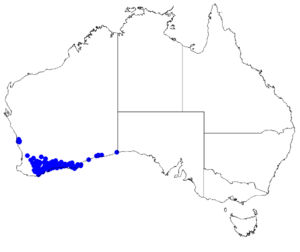Boronia crassifolia facts for kids
Quick facts for kids Boronia crassifolia |
|
|---|---|
| Scientific classification | |
 |
|
| Where this plant grows in Australia |
Boronia crassifolia is a special plant that belongs to the citrus family, called Rutaceae. This plant is endemic to the south-west part of Western Australia. This means it naturally grows only in that area and nowhere else in the world! It's a small, thin shrub with leaves that look like feathers (called pinnate leaves). Its flowers are usually yellowish-green to brownish and have four petals.
Contents
Discovering Boronia crassifolia
Boronia crassifolia is a slim, rounded shrub. It usually grows to be about 30 cm (10 in) tall, which is about the length of a school ruler.
What its leaves and flowers look like
Its leaves are special because they are pinnate. This means they have smaller leaflets arranged on either side of a central stem, like a feather. Each leaf can have three, five, or seven of these small leaflets. These leaflets are thin and long, or shaped a bit like a small spoon. They are usually about 5–10 mm (0.2–0.4 in) long.
The flowers of Boronia crassifolia are yellowish-green to brownish. They are about 10 mm (0.4 in) wide, which is roughly the size of a small button. These flowers hang from where the leaves meet the stem. Each flower has four red parts called sepals, which are like small leaves that protect the bud. They are about 2.5 mm (0.1 in) long. The four petals are a bit longer, about 4 mm (0.2 in). Inside the flower, there are eight stamens (the parts that make pollen). Some stamens are longer than others.
How Boronia crassifolia got its name
The plant Boronia crassifolia was first officially described in 1845. This was done by a scientist named Friedrich Gottlieb Bartling. He published his description in a book called Plantae Preissianae.
Meaning of its scientific name
The second part of its scientific name, crassifolia, comes from two Latin words:
- crassus means "thick" or "stout".
- folium means "a leaf".
So, crassifolia basically means "thick-leaved", even though its leaves are described as slender!
Where Boronia crassifolia lives
This type of boronia plant likes to grow on sandy plains and sand dunes. You can often find it among rocks near a place called Mount Lesueur. It also grows in areas from near the city of Perth all the way to the Stirling Range and east towards Twilight Cove.
It lives in several different natural areas (called biogeographic regions) in Western Australia. These include the Avon Wheatbelt, Esperance Plains, Geraldton Sandplains, Hampton, Jarrah Forest, and Mallee regions.

